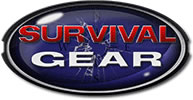Survival Kit Checklist
When I'm assembling a new survival kit, I always find it helpful to work from a survival kit checklist. This allows me to organize my thoughts on paper before committing to adding perhaps unnecessary supplies to a kit.
Survival Kit Checklist
The checklist also prevents me from overlooking some needed component. Regardless of the size or intended purpose of the kit, it should meet your basic needs during or immediately following a disaster or crisis.
What I find useful is to take my survival kit checklist and break it into sections, with each section focusing on meeting one of my basic needs.
These needs are:
- Water
- Food
- Shelter / Fire
- First Aid
- Hygiene
- Lighting
- Tools
Naturally, the overall size of the kit will dictate how I meet those needs. A full-size hiking backpack will afford me much more space than a fanny pack. Regardless of the pack size though, weight is always a concern. So, while a large pack would give me the room for canned goods, I'll not include them because they are too heavy.
Also, while some items I'd include in a survival kit may serve multiple purposes, I only list them under their primary use category. For example, hand sanitizer not only cleans hands but because of the high alcohol content, it will help get a fire going. But, I'll just list it under Hygiene and leave it at that.
To meet my water needs, I'll usually start with one or two water bottles. One liter seems to be a good size for most kits. I'll then add means of purifying more water, such as purification tablets. Depending on how large of a kit I'm building, I might include a small pot I can use to boil water as well. Coffee filters are present on almost all of my survival kit checklists as they work very well for filtering out sediment from questionable water sources.
For food, I often stick with just some basics, like granola bars and dried fruit. I want something that is going to provide a good amount of calories in a small, easily stored package. I tend to avoid most dehydrated foods as I don't want to have to rely on cooking.
Space blankets are also present in all my survival kits. They fold up very small, weigh next to nothing, yet work exceedingly well in retaining my body heat and keeping the wind out. I also like to include 550 paracord whenever possible as it is very useful when constructing expedient shelters. For lighting fires, I include strike anywhere matches, butane lighters, and dryer lint as tinder.
Every survival kit checklist should have at least minimal first aid supplies. The absolute bare minimum would include adhesive bandages, burn cream, antibiotic ointment, and pain relievers like ibuprofen. Because I'm an admitted caffeine junkie, I usually toss in a few caffeine tablets as well to stave off withdrawal headaches.
Even the smallest survival kit I build will have a supply of baby wipes. If I have the room, I'll also toss in a roll of toilet paper. Remove the cardboard tube and place it in a plastic bag. Without the cardboard, it is easy to crush it down to a much smaller size. In a larger kit, I'll also include a bar of soap, wash cloth, and even toothpaste and a toothbrush. Keeping clean will reduce the possibility of illness and infection. Hand sanitizer works well in this stead too.
Lighting is satisfied by some form of flashlight and/or head lamp. The size of these items is dictated by the overall size of the pack. Spare batteries for these is a must as well. If I have room, I'll stuff in a few glow sticks I'll pick up at my local dollar store.
As for tools, a sharp knife is on top of the survival kit checklist. A knife will be of great help in a variety of tasks, from building a shelter to preparing food. Duct tape is an excellent resource as well. A multi-tool is also useful, but don't replace your sharp knife with it. Keep both of them in the kit if you have the space.
As you can see, a survival kit checklist will change depending on the size of the kit. But, using the checklist approach will keep you organized and prevent you from overlooking key elements.
